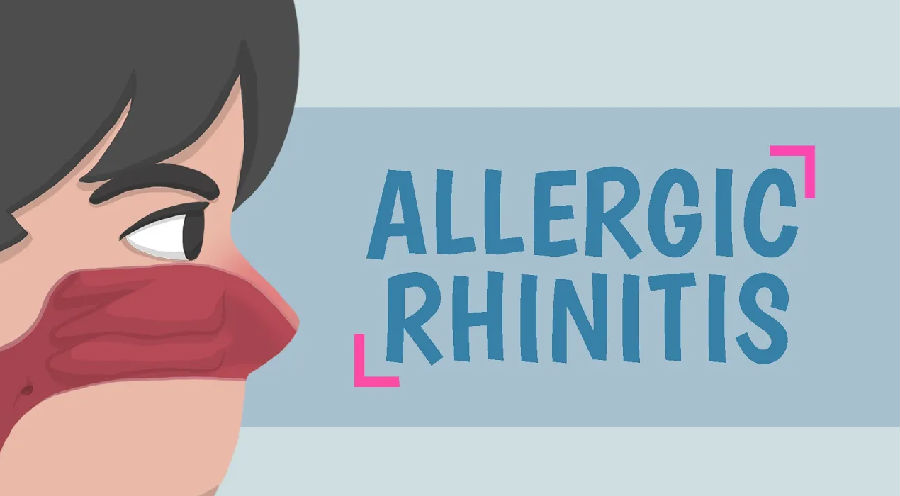(单词翻译:单击)
Allergic Rhinitis. 'Rhin' comes from Greek word, meaning 'nose', and 'itis' means inflammation.
过敏性鼻炎。“Rhin”来自希腊语,意思是“鼻子”,而“itis”表示炎症。
So it means 'Inflammation of the Nose', and 'Allergic' means it's caused by allergens.
所以它的意思是“鼻子发炎”,“过敏”是指它是由过敏原引起的。
Allergens are anything harmless (or neutral) that can be inhaled in air by nose and trigger excessive immune reaction.
过敏原是可以通过鼻子吸入空气中并引发过度免疫反应的无害(或中性)物质。
Common examples of allergens include pollen and dust.
常见的过敏原包括花粉和灰尘。
Once inside nose, they will meet immune system, particularly Mast cells attached to IgE antibodies.
一旦进入鼻子,它们就会遇到免疫系统,尤其是附着在IgE抗体上的肥大细胞。
Allergen will bind to IgE antibody which will then activate and alert Mast cells.
过敏原将与IgE抗体结合,然后激活并提醒肥大细胞。
In a normal person, the reaction is minimal. But in those suffering from Allergic rhinitis, this cell over-reacts big time.
在正常人中,这一反应会比较小。但在那些患有过敏性鼻炎的人中,这种细胞反应会过度。
It signals to all cells in surrounding by releasing histamine.
它通过释放组胺向周围的所有细胞发出信号。
Histamine will now cause inflammation and swelling up of nasal mucosa which will then cause excessive mucus production.
组胺随即会引起鼻粘膜发炎和肿胀,从而导致粘液的大量产生。
This results in Nasal Drip. This excessive mucus production will block two very important structures opening in nose.
这就会导致鼻滴。过多的粘液产生,会使鼻子中两个非常重要的结构阻塞。
1) Nasolacrimal duct: the purpose of this duct is to drain tears from eyes into nose.
1)鼻泪管:其功能是将眼泪从眼睛排入鼻腔。
But once blocked by excessive mucus production by allergic rhinitis, now you will start having watery eyes.
但是一旦被过敏性鼻炎产生的过多粘液阻塞,你的眼睛就会开始流泪。
2) Eustachian Tube: This drains drainage from middle ear.
2)咽鼓管:从中耳排出引流液。
With it blocked too by excessive mucus production by allergic rhinitis, now you will have stuffed ears sensation too.
由于过敏性鼻炎产生过多的粘液也阻塞了它,现在你也会有耳朵堵塞的感觉。
Finally, the nerves in nasal cavity will start getting irritated and lead to sneezing.
最后,鼻腔内的神经会开始受到刺激并导致打喷嚏。
All of it will lead to difficulty in breathing for person suffering from Allergic rhinitis.
所有这些都会导致过敏性鼻炎患者呼吸困难。

To summarize, Allergic rhinitis will lead to
总结起来,过敏性鼻炎会导致
1: The swelling and congestion of nasal mucosa
1:鼻黏膜肿胀充血
2: Watery eyes
2:流泪
3: Stuffed ears
3:耳塞
4: Nasal drip due to excessive mucus production
4:粘液分泌过多导致流鼻涕
5: Sneezing
5:打喷嚏
6: Difficulty breathing.
6:呼吸困难。
Treatment of Allergic Rhinitis is achieved by targeting different steps in pathway to allergy:
过敏性鼻炎的治疗是通过针对过敏途径中的不同步骤来实现的:
1) Avoid Allergens
1)避免过敏原
This can be done by taking precautionary measures to avoid exposure. For example, wearing face masks in pollen season.
这可以通过采取预防措施避免接触来完成。例如,在花粉季节戴口罩。
2) Decrease inflammation
2)减少炎症
This can be achieved by steroids applied directly to nasal mucosa.
可以通过将类固醇直接应用于鼻粘膜来实现。
3) Anti-Histamines
3)抗组胺药
These target the action of histamines by blocking the histamine receptors, thus stopping the action of histamine.
这是通过阻断组胺受体来靶向组胺作用,从而停止组胺的作用。
4) Mast Cell stabilizers
4)肥大细胞稳定剂
Mast cell stabilizers are common medications used to prevent or control certain allergic disorders.
肥大细胞稳定剂是用于预防或控制某些过敏性疾病的常用药物。
They block a calcium channel essential for mast cell degranulation, stabilizing the cell, and thereby preventing the release of histamine.
它们阻断肥大细胞脱粒所必需的钙通道,稳定细胞,从而抑制组胺的释放。
5) Immunotherapy
5) 免疫疗法
When you get immunotherapy in the form of allergy shots, your allergist or doctor injects small doses of substances that you are allergic to (allergens) under your skin.
当你以过敏针的形式接受免疫疗法时,你的过敏症专科医生或普通医生,会在你的皮肤下注射小剂量的过敏物质(过敏原)。
This helps your body "get used to" the allergen, which can result in fewer or less severe symptoms of allergic rhinitis.
这有助于你的身体“习惯”过敏原,从而减少或减轻过敏性鼻炎的严重症状。


